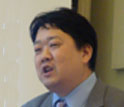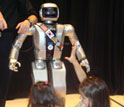Media Advisory 10-004
National Science Board to Meet on Feb. 3 and 4 at NSF Headquarters
Presentations about NSF's future will be on the agenda, including updates on major facilities and plans and the spending of NSF ARRA funds

A 180-degree fisheye view of the Gemini North telescope on Mauna Kea, Hawaii.
February 1, 2010
This material is available primarily for archival purposes. Telephone numbers or other contact information may be out of date; please see current contact information at media contacts.
The National Science Board (NSB) will embark on its first of five meetings of 2010 related to national science and engineering policy issues and the National Science Foundation (NSF) on Wednesday and Thursday, Feb. 3 and 4, 2010. Much of the meeting's agenda will focus on plans for major facilities and high-profile programs devoted to research at the ends of the globe, over a mile and a half beneath the surface of our planet, or thousands of light years away from the Earth. The NSB will also be briefed by the NSF Director on NSF's spending of its $3 billion portion of the American Recovery and Reinvestment Act (ARRA).
Members of the media and the public are invited to public portions of the meeting. Highlights include:
WEDNESDAY, FEB. 3, 2010
8:30 a.m. to 10:00 a.m - Committee on Programs and Plans (CPP)
- The NSB will discuss broader community access to data produced by LIGO, the Laser Interferometer Gravitational-Wave Observatory, a facility dedicated to the detection of cosmic gravitational waves, and also the harnessing of the waves collected in two facilities in Hanford, Washington, and in Livingston, Louisiana, for scientific research.
- The NSB will review preliminary design efforts of DUSEL, the Deep Underground Science and Engineering Laboratory in Leed, South Dakota (where the NSB intends to hold its off-site meeting in the Fall of 2010); and
- The NSB will evaluate NSF's cyberinfrastructure vision for the 21st Century.
1 p.m. to 1:45 p.m. - CPP's Subcommittee on Polar Programs.
The NSB will discuss the infrastructure and logistical needs in the Antarctic for the next decades.
THURSDAY, FEB. 4
8 a.m. to 9:30 a.m. - Committee on Programs and Plans
Information on the following high-profile NSF programs will be presented:
- Supercomputing facilities at the National Center for Atmospheric Research (NCAR) in Colorado;
- The National High Magnetic Field (or the "Magnet Lab"), headquartered in Tallahassee, Fla.;
- Extension of the cooperative agreement for the Gemini Observatory, which affords access to the entire sky via twin 8-meter optical/infrared telescopes located on mountains in Hawaii and Chile;
- Experimental Program to Stimulate Competitive Research (EPSCoR) awards for cyberinfrastructure; and
- NSF's Academic Research Infrastructure (ARI) program, an effort to fund repairs and renovations at the nation's academic research facilities, for which the ARRA designated $200 million for competitive grants to be administered by NSF.
9:30 a.m. to 10:00 a.m. - Committee on Science and Engineering Indicators (SEI)
- An update will be given on SEI 2010, delivered to the President and Congress and publicly rolled out at the White House on January 15, 2010; and
- Plans will be outlined for another public rollout of SEI 2010 and the NSB's companion piece, "Globalization of Science and Engineering Research" at a press confererence during the annual AAAS meeting this year in San Diego (Friday, Feb. 19 at 3:00 p.m.)
11:30 a.m. to noon - Plenary Open: 60th Anniversary Distinguished Speaker Paul Oh
Paul Oh is associate department head at Drexel University's Mechanical Engineering Department and director of the Drexel Autonomous Systems Lab where he pursues two passions: aerodynamics and robotics. He will discuss research, design and development of robotics and unmanned systems. In 2008, Oh was appointed to serve NSF as a program director for robotics in its directorate for computer and information science and engineering (CISE). In the summer of 2009, Jaemi Hubo, an international robotic collaborative for which he served as principal investigator, was unveiled.
Visit: http://www.nsf.gov/nsb/meetings/2010/0203/ for the full meeting agenda.
The NSB is the 25-member policymaking body for NSF and advisory body to the president and Congress on science and engineering issues. Drawn from industry and universities, and representing a variety of science and engineering disciplines and geographic areas, NSB members are selected for their eminence in research, education or public service, and records of distinguished service. NSB members are appointed for six-year terms. The NSF director is an ex officio member of the NSB. The newest members of the NSB were sworn in during the December 2008 meeting. For more background on the NSB and its current composition, visit: http://www.nsf.gov/nsb/about/index.jsp.
Note: Reporters are invited to attend all open sessions, subject to provisions of the Government in the Sunshine Act. All sessions will be held at the NSF headquarters: 4201 Wilson Boulevard, Arlington, Va. Journalists interested in attending and covering the meeting and/or interviewing NSF or NSB officials should contact Lisa-Joy Zgorski at 703-292-8311 by 5 p.m. on Tuesday, Feb. 2, 2010, to make arrangements.
-NSF-
-
Paul Oh will address the NSB on Thurs., Feb. 4 at 11:30 a.m. as its 60th Anniversary Speaker.
Credit and Larger Version -
Children reach out for Jaemi Hubo, an NSF-funded international robotics collaborative.
Credit and Larger Version
Media Contacts
Lisa-Joy Zgorski, NSF, (703) 292-8311, email: lisajoy@nsf.gov
Program Contacts
Kim L. Silverman, NSF, (703) 292-4515, email: ksilverm@nsf.gov
Related Websites
Unveiling of Jaemi Hubo, NSF-sponsored robotics: http://www.nsf.gov/news/news_summ.jsp?cntn_id=114909&org=NSF&from=news
The U.S. National Science Foundation propels the nation forward by advancing fundamental research in all fields of science and engineering. NSF supports research and people by providing facilities, instruments and funding to support their ingenuity and sustain the U.S. as a global leader in research and innovation. With a fiscal year 2023 budget of $9.5 billion, NSF funds reach all 50 states through grants to nearly 2,000 colleges, universities and institutions. Each year, NSF receives more than 40,000 competitive proposals and makes about 11,000 new awards. Those awards include support for cooperative research with industry, Arctic and Antarctic research and operations, and U.S. participation in international scientific efforts.
Connect with us online
NSF website: nsf.gov
NSF News: nsf.gov/news
For News Media: nsf.gov/news/newsroom
Statistics: nsf.gov/statistics/
Awards database: nsf.gov/awardsearch/
Follow us on social
Twitter: twitter.com/NSF
Facebook: facebook.com/US.NSF
Instagram: instagram.com/nsfgov




